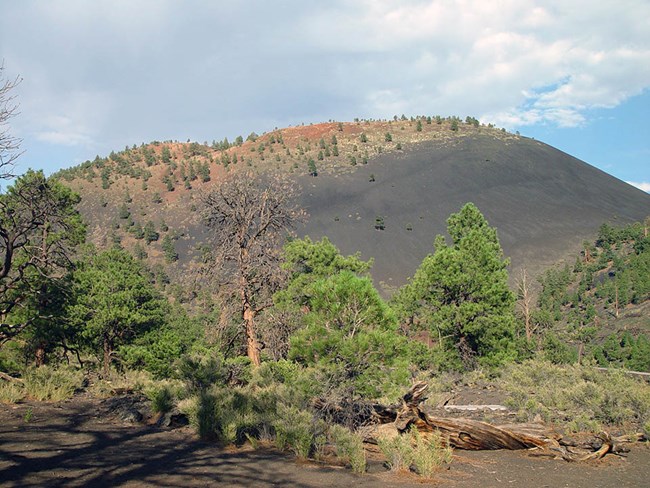
NPS
Sunset Crater Volcano National Monument encompasses 3032 acres (1227 ha) in north central Arizona. It was established in 1930 to protect significant geological resources of a volcanic eruption that occurred about 900 years ago. In addition to their scientific value, the volcano and associated natural resources continue to have cultural significance to contemporary native tribes.
The vegetation of Sunset Crater Volcano NM is diverse and includes nearly barren cinder beds and rock outcrops, grassy meadows, open stands of trees with sparse understory shrublands, and dense forests on more moist aspects of the highest slopes, drainages, and ridges. Ponderosa pine forests dominate deep cinder deposits and pinyon-juniper woodlands occur in the northwestern portion of the monument.
Surface water is almost non-existent within the monument and some areas, such as the Bonito Lava Flow, are so inhospitable that they likely provide little habitat for wildlife. However, unique habitats have been found within the monument that may shed light on the ecological processes that allow pioneer plants to move into harsh habitats and eventually transform them. Two amphibian, 117 avian, 29 mammalian, and 10 reptilian species have been documented in the monument.
Monitored Here
Species Lists
Select a Park:
Select a Species Category (optional):
Visit NPSpecies for more comprehensive information and advanced search capability. Have a suggestion or comment on this list? Let us know.
Life Zones
Sunset Crater Volcano NM ranges in elevation from 6,810 to 8,010 feet (2,076–2,441 m) at the top of the Sunset Crater cinder cone, and spans the Semi-Desert Grassland/Shrub Steppe, Pinyon-Juniper Woodland and Ponderosa Pine Forest life zones. The monument experiences an average annual precipitation of 16.77 inches (426 mm).

Climate Summary Chart
Charts are an effective way to summarize and graphically represent climate variables. The following chart is based on the diagrams developed for vegetation studies by Walter and Lieth in 1967. Visit our climate page for more information.

Reports & Publications
Inventories are point-in-time surveys that help us learn about the resources in our parks. Information obtained through the Southern Colorado Plateau Network’s inventories of park resources helped to establish a base level of data, which has served as a starting point for our natural resource monitoring.
Source: NPS DataStore Saved Search 3515 (results presented are a subset). To search for additional information, visit the NPS DataStore.
Source: NPS DataStore Saved Search 3280 (results presented are a subset). To search for additional information, visit the NPS DataStore.
Last updated: November 6, 2018
